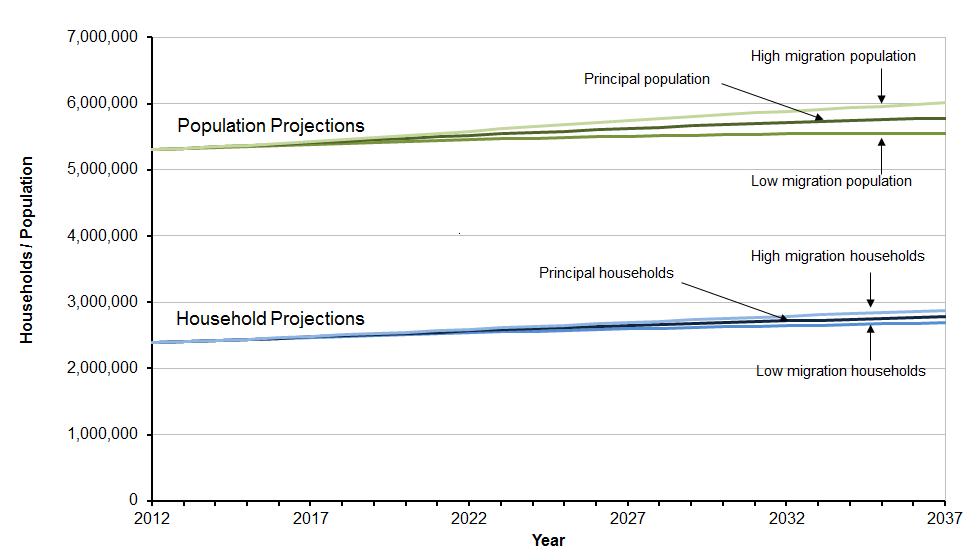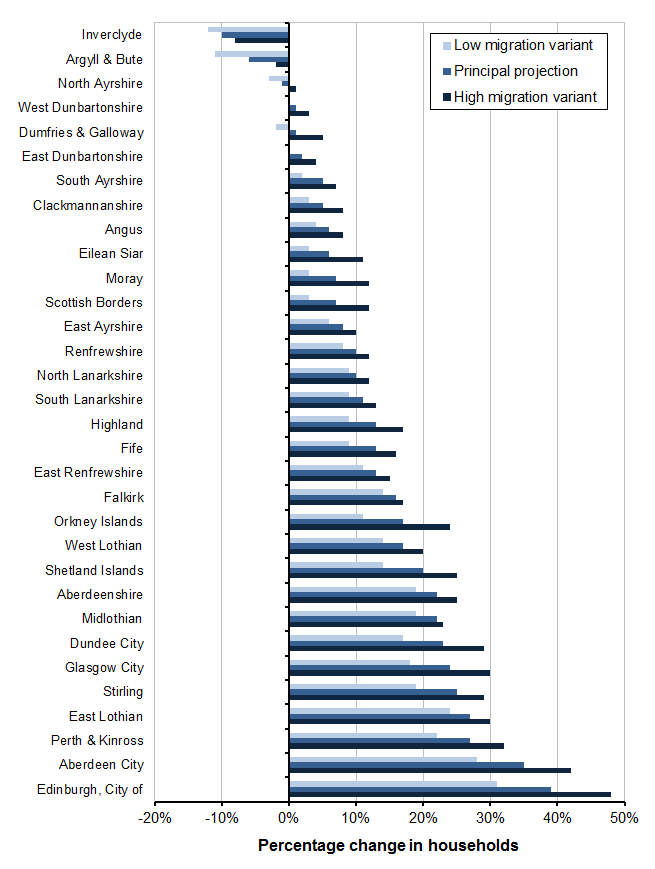5.1.1 Variant projections provide a broad indication of the sensitivity of the household projections to the demographic assumptions that are used to produce them. The principal household projection is based on the principal population projection produced by the National Records of Scotland (NRS), which uses assumptions about fertility, mortality and migration which are thought to be the most likely to occur over the next 25 years. The household projection is also dependent on the assumption that the projected trends in household formation will continue until 2037.
5.1.2 Two variant household projections are presented here. These are based upon variant population projections produced by NRS that use different assumptions regarding future migration. Summary results for the variant projections are presented here. Table 20 shows the total number of households projected for 2037, for each variant, by Council area. Table 21 shows the proportion of households in each household type in 2037, for each variant. These, and additional comparisons, are discussed below. Full results of each variant projection, by Council area, are available from the NRS website.
5.2.1 The low and high migration variant population projections use the same assumptions about fertility and mortality as the principal population projection but assume varied levels of migration to and from Scotland. The migration assumptions, by Council area, can be found in Annexes D, E and F of the ‘2012-based population projections for Scottish Areas’ on the NRS website.
5.2.2 Migration variant household projections are calculated by replacing the principal population projection with a variant migration population projections, keeping all other inputs to the household projections (communal establishment rates, headship rates, survey data and household estimates) unchanged.
5.2.3 The principal household projection shows the number of households in Scotland increasing from 2.39 million households in 2012 to 2.78 million households in 2037. This compares to 2.69 million households for the low migration variant and 2.88 million households for the high migration variant in 2037. Figure 20 illustrates this, along with the projected increase in population for the principal and variant projections. The percentage increase in households between 2012 and 2037 is 13 per cent for the low migration variant and 21 per cent for the high migration variant, compared to 17 per cent for the principal projection.

5.2.4 The use of different population projections has little effect on the type of households that the population is living in. The proportions of all households in each household type differ from the principal projection by less than 0.4 percentage points (Table 21). In 2037, average household size in the low and high migration projections is 2.02 and 2.04 respectively, compared to 2.03 in the principal household projection. The differences are small as the assumptions about household formation are the same in each projection. The small differences in each projection are due to differences in the age distribution of the underlying populations, as different age groups tend to form different types of household.
5.2.5 There are differences in the age groups of the heads of household between the projections. These are caused by different age distributions in the variant population projections, as the age groups of migrants are not necessarily typical of the overall population (migrants tend to be younger). The differences in the proportion of all households that are headed by each age group, compared to the principal population, are small (less than one percentage point) for both variant projections (Table 22). The largest differences are seen in the 30-44 age group, where the proportion of all households is 0.9 percentage points smaller than in the principal projection in the low migration variant and 0.8 percentage points larger in the high migration variant.
5.2.6 Table 20 shows the projected number of households for each Council area in the principal, low and high migration variants for 2037. The migration variants tend to have the biggest impact on the areas which have relatively high levels in- and out-migration. The impacts are biggest for the City of Edinburgh, Orkney Islands and Aberdeen City (differences of about six per cent between each of the variants and the main projections).
5.2.7 Figure 21 compares the percentage change in households from 2012 to 2037 under the principal, low and high migration variant projections for each Council area.
